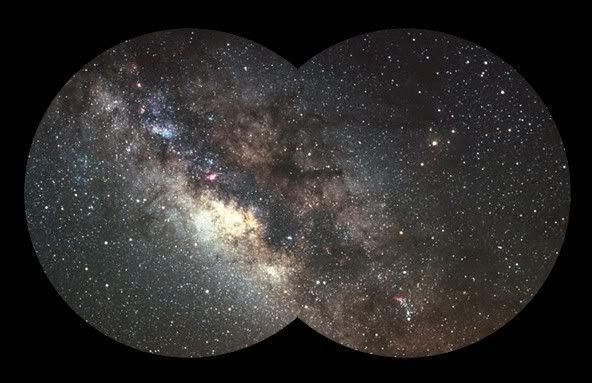Skip to comments.
Astronomers unveil first Large Binocular Telescope findings
Laser Focus World ^
| Thursday, March 15, 2012
| John Wallace
Posted on 03/17/2012 11:21:32 PM PDT by SunkenCiv
Today, astronomers at the Large Binocular Telescope (LBT) released the first series of scientific results from the LBT, including images of extrasolar planets. The LBT has two 8.4 m borosilicate glass honeycomb primary mirrors spaced apart 14.4 m center-to-center, allowing the IR telescope to achieve the diffraction-limited imaging of a single mirror with a 22.8 m aperture. Adaptive-optics secondary mirrors correct for atmospheric turbulence. The LBT is located on Mt. Graham in southeastern Arizona.
"With this unrivaled new technology, we can now probe the close-in environments of nearby stars with a clarity that was previously not possible," said Richard Green, director of the LBT. "We expect these to be the first of many amazing new discoveries as we are now able to observe in unique detail the formation of stars and their systems of planets."
(Excerpt) Read more at laserfocusworld.com ...
TOPICS: Astronomy; Science
KEYWORDS: binoculartelescope; xplanets
Four young stars in the Orion Trapezium cluster 1,350 light-years away are imaged by the LBT. This is the best image ever taken of these stars, which are all tightly located within 1 arcsecond of each other. By comparing this 2.16 micron infrared image to past images of this group over the last 15 years, astronomers can now see the motion of each star with respect to the others. The movements show that the stars in the mini-cluster were born together but will likely disperse as the stars age and interact with each other. (Image: LBT Observatory)

The HR8799 planetary system is seen in two different IR wavelengths -- on the left, in the H band (1.65 microns); and on the right, in a narrow band centered on 3.3 microns which is sensitive to absorption by methane. All four planets are visible. This is the first time the innermost planet, HR8799e, has been imaged at either wavelength. The scale line spans 1 arcsecond. (Image: LBT Observatory)

1
posted on
03/17/2012 11:21:38 PM PDT
by
SunkenCiv
To: brytlea; cripplecreek; decimon; bigheadfred; KoRn; Grammy; married21; steelyourfaith; Mmogamer; ...
An "extra, extra" ping to the APoD list members.
2
posted on
03/17/2012 11:25:33 PM PDT
by
SunkenCiv
(I come to bury Caesar, not to praise him)
To: KevinDavis; annie laurie; Knitting A Conundrum; Viking2002; Ernest_at_the_Beach; Mmogamer; ...
two 8.4 m borosilicate glass honeycomb primary mirrors
By contrast, the Hale 200" reflector on Mt Palomar is a bit more than 5 meters. And it's a single mirror. I've seen the scratch (first attempt) of that at Corning Museum of Glass, setting on one edge, and it's huge. This is one big-assed pair of binoculars.
3
posted on
03/17/2012 11:25:40 PM PDT
by
SunkenCiv
(I come to bury Caesar, not to praise him)
To: SunkenCiv
Will they have to photoshop out the area in black that surrounds the image and looks like this?

Yes I made a Binocular Joke
4
posted on
03/17/2012 11:43:30 PM PDT
by
GraceG
To: SunkenCiv
Are the G’s going to be upset that they have been excluded from the telescope’s acronym?
To: SunkenCiv
Next thing you know the Large Gigantic Binocular Telescopes (LGBT) will demand the right to marry each other.
6
posted on
03/18/2012 12:10:36 AM PDT
by
Telepathic Intruder
(The right thing is not always the popular thing)
To: SunkenCiv
The telescope the environmentalists couldn’t kill. Or in Obama speak, “If the Republicans were around when this telescope was proposed, we’d be feeding squirrels on Mt. Graham.”
To: GraceG
Yes I made a Binocular Joke You oort to stop that.
8
posted on
03/18/2012 1:12:21 AM PDT
by
VeniVidiVici
(Democrats love direct democracy until it's time to vote on something. Then they scream for a judge)
To: VeniVidiVici
[ Yes I made a Binocular Joke
You oort to stop that. ]
Oh it’s on! :)
9
posted on
03/18/2012 5:10:48 AM PDT
by
GraceG
To: GraceG
That actually looks like a MOON.
To: left that other site
That actually looks like a MOON.
That’s no moon.....
It’s a Battlestation....
11
posted on
03/18/2012 5:31:53 AM PDT
by
GraceG
To: GraceG
To: GraceG
That actually looks like a MOON.
That’s no moon.....
It’s a Battlestation....
—
Which is the unfortunate problem with using computers to process the information - the stuff they do not expect gets filltered out as noise - like ion trails ...
13
posted on
03/18/2012 6:10:59 AM PDT
by
PIF
(They came for me and mine ... now it is your turn ...)
To: SunkenCiv
And here I used to think I had a set of big binos using these
 I did occasionally try to use them for stargazing. Needless to say, if there was any ship's motion (almost inevitable at sea), it was a matter of catching glimpses of the object as it went rushing through the field of view.
I did occasionally try to use them for stargazing. Needless to say, if there was any ship's motion (almost inevitable at sea), it was a matter of catching glimpses of the object as it went rushing through the field of view.
Disclaimer:
Opinions posted on Free Republic are those of the individual
posters and do not necessarily represent the opinion of Free Republic or its
management. All materials posted herein are protected by copyright law and the
exemption for fair use of copyrighted works.
FreeRepublic.com is powered by software copyright 2000-2008 John Robinson




 I did occasionally try to use them for stargazing. Needless to say, if there was any ship's motion (almost inevitable at sea), it was a matter of catching glimpses of the object as it went rushing through the field of view.
I did occasionally try to use them for stargazing. Needless to say, if there was any ship's motion (almost inevitable at sea), it was a matter of catching glimpses of the object as it went rushing through the field of view.